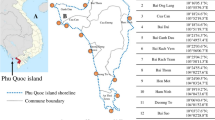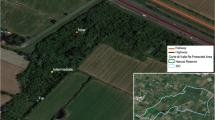Abstract
This study examined fatalities due to rip currents in the gendarmerie region of the Black Sea coasts of Istanbul during the period of 2007–2012. Effects of social and religious aspects to the nature and extend of incidents are emphasized. Analyses include the incidence rate of fatalities from rip currents, their causes, temporal and spatial distributions. Gendarmerie hazard event records show that 68 % of all drowning fatalities are associated with rip currents and that on average 33 people die from rip currents each year on the Black Sea beaches of Istanbul. Fifty-four percentage of fatalities are between 18 and 35 years of age. Difference in gender vulnerability is quite pronounced; males are nearly seven times more likely to fall victim to a deadly rip current than females. Weekends naturally have more fatalities than any other day of the week. As expected, summer season weekends are observed to have more fatalities than any other time of the year. July is the most hazardous month and is followed by August. The Muslim fasting month of Ramadan has a significant effect on reducing the fatalities with only six reported deaths during the period of 2007–2012.





Similar content being viewed by others
Notes
Cekenakinti means “rip current” in Turkish.
References
Arozarena I, Houser C, Echeverria AG, Brannstrom C (2015) The rip current hazard in Costa Rica. Nat Hazards. doi:10.1007/s11069-015-1626-9
Ballantyne R, Carr N, Hughes K (2005) Between the flags: an assessment of domestic and international university students’ knowledge of beach safety in Australia. Tour Manag 26(4):617–622
Barlas B, Beji S (2013) Drownings associated with rip currents in the gendarmerie region of Istanbul. In: Proceedings of rip currents and drownings workshop, Istanbul, pp 1–12 (in Turkish)
Barlas B, Beji S, Taşçı ÖE, Işık M (2012) Investigation of rip currents in Istanbul’s coastline. In: Proceedings of technical congress of naval architecture and ocean engineering, Istanbul, pp 299–308 (in Turkish)
Beji S, Barlas B (2007) The investigation of rip currents that cause drownings off the coast of Şile/Istanbul. Research report, chamber of Turkish naval architects and marine engineers, Istanbul (in Turkish)
Beji S, Barlas B (2013) Mechanism of rip currents. In: Proceedings of rip currents and drownings workshop, Istanbul, pp 13–22 (in Turkish)
Brannstrom C, Trimble S, Santos A, Brown HL, Houser C (2014) Perception of the rip current hazard on Galveston Island and North Padre Island, Texas, USA. Nat Hazards 72:1123–1138
Brewster BC (2010) Rip current misunderstandings. Nat Hazards 55:161–162
Brighton B, Sherker S, Brander R, Bradstreet A (2013) Rip current related drowning deaths and rescues in Australia 2004–2011. Nat Hazards Earth Syst Sci 13:1069–1075
Caldwell N, Houser C, Meyer-Arendt K (2013) Ability of beach users to identify rip currents at Pensacola Beach, Florida. Nat Hazards 68:1041–1056
Chandramohan P, Kumar VS, Jena BK (1997) Rip current zones along beaches in Goa, West Coast of India. J Waterw Port Coast Ocean Eng 123(6):322–328
Dalrymple RA, MacMahan JH, Reniers JHM, Nelko V (2011) Rip currents. Annu Rev Fluid Mech 43:551–581
Drozdzewski D, Shaw W, Dominey-Howes D, Brander RW et al (2012) Surveying rip current survivors: preliminary insights into the experiences of being caught in rip currents. Nat Hazards Earth Syst Sci 12:1201–1211
Drozdzewski D, Roberts A, Dominey-Howes D, Brander RW (2015) The experiences of weak and non-swimmers caught in rip currents at Australian beaches. Aust Geogr 46(1):15–32
Gensini VA, Ashley WS (2010) An examination of rip current fatalities in the United States. Nat Hazards 54:159–175
Hatfield J, Williamson A, Sherker S, Brander RW et al (2012) Development and evaluation of an intervention to reduce rip current related beach drowning. Accid Anal Prev 46:45–51
Lushine JB (1991) A study of rip current drownings and related weather factors. Natl Wea Dig 16:13–19
McCarroll RJ, Brander RW, MacMahan J et al (2014) Evaluation of swimmer-based rip current escape strategies. Nat Hazards 71(3):1821–1846
Miloshis M, Stephenson WJ (2011) Rip current escape strategies: lessons for swimmers and coastal rescue authorities. Nat Hazards 59:823–832
Morgan D, Ozanne-Smith J, Triggs T (2009) Self-reported water and drowning risk exposure at surf beaches. Aust N Z J Public Health 33:180–188
Sabet BS, Barani GA (2011) Field investigation of rip currents along the southern coast of the Caspian sea. Sci Iran A 18(4):878–884
Sherker S, Williamson A, Hatfield J, Brander R, Hayen A (2010) Beachgoers’ beliefs and behaviours in relation to beach flags and rip currents. Accid Anal Prev 42:1785–1804
Williamson A, Hatfield J, Sherker S, Brander RW, Hayen A (2012) A comparison of attitudes and knowledge of beach safety for Australian beachgoers, rural residents and international tourists. Aust N Z J Public Health 36(4):385–391
Acknowledgments
The authors would like to thank Istanbul Gendarmerie Command’s officers for sharing their valuable data and Istanbul Development Agency for partial support of this research through the project ISTKA/2012/GNC-80. The authors also would like to express their sincere gratitude to two anonymous reviewers whose elaborate and constructive comments improved the presentation of this work greatly.
Author information
Authors and Affiliations
Corresponding author
Rights and permissions
About this article
Cite this article
Barlas, B., Beji, S. Rip current fatalities on the Black Sea beaches of Istanbul and effects of cultural aspects in shaping the incidents. Nat Hazards 80, 811–821 (2016). https://doi.org/10.1007/s11069-015-1998-x
Received:
Accepted:
Published:
Issue Date:
DOI: https://doi.org/10.1007/s11069-015-1998-x




